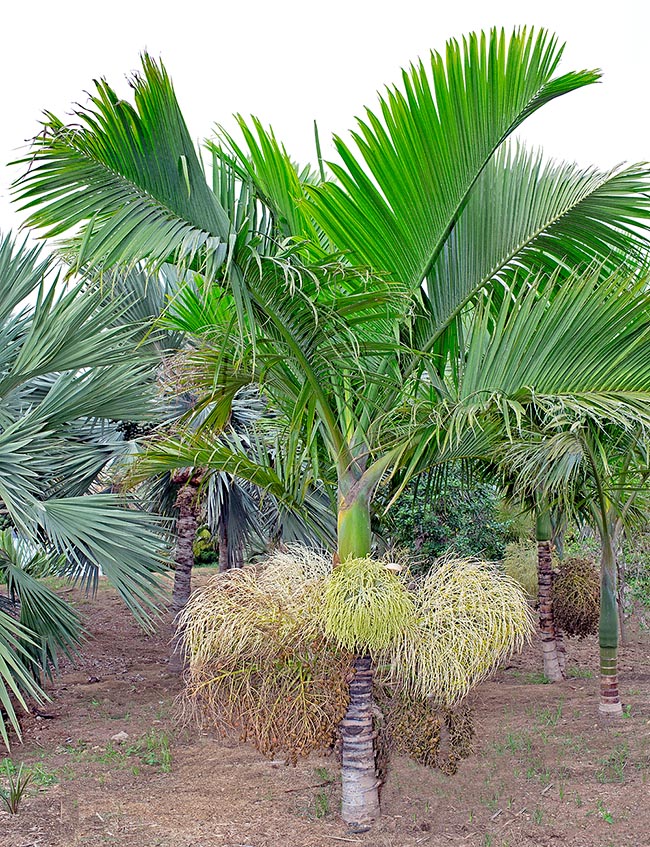Family : Arecaceae

Text © Pietro Puccio

English translation by Mario Beltramini
The species is native to Réunion (France) in the Indian Ocean where is present in a limited number of individuals in the humid forest, between 200 and 600 m of altitude.
The name of the genus is the combination of the Greek substantives “ὗς, ὑός” (ys, yόs) = swine and “φορβή” (phorbé) = forage, food; the specific name is the Latin adjective “indicus, a, um” = of India, Indian.
Common names: poison palm (English); palmier bâtard, palmiste cochon, palmiste poison (French).
The Hyophorbe indica Gaertn. (1791) is an unarmed monoecious species with solitary erect stem, greyish, smooth, cylindrical with slightly enlarged base, up to 10 m tall with a diameter of 13-18 cm, marked by the rings of the scars of the fallen leaves.
The crown is formed by 5-8 pinnate leaves, on a 30-60 cm long petiole, ascending, elegantly arcuate, 1,5-2,2 m long, with 90-100 lanceolate leaflets per side with acute apex, rather rigid, in the median part 60 cm long and 4-5 cm broad, regularly arranged along the rachis and facing upwards, of intense glossy green colour above, greyish green below.

At risk of extinction in nature, the Hyophorbe indica is native to Réunion where it can be 10 m tall © Giuseppe Mazza
The tubular leaf sheath, swollen at the base, of pale green colour varying to reddish brown in the young plants, wraps wholly the stem for a length of 50-90 cm.
Very ramified inflorescence under the leaves (infrafoliar), initially enclosed in an erect rust-coloured spathe, with unisexual flowers on the same inflorescence, of white colour, fragrant, sessile, arranged in lined groups (acervuli) with a female flower at the base followed by 3-4 male flowers. Male flowers with 3 sepals, 3 petals, 6 stamens and one pistillode, female flowers with 3 sepals, 3 petals, 6 staminodes and trilocular gynoecium with three curved stigmata. The male flowers open and fall in sequence starting from that placed at the tip, when all those of the group have fallen the female flower opens, this favours the crossed fecundation.
Obovoid wrinkled fruits initially of green colour, then orange red when ripe, 2,5-3,2 cm long and of 1,6-2,2 cm of diameter, containing only one seed 2-2,5 cm long and of 1-1,5 of diameter.
It reproduces by seed, previously kept in water for 3 days, in particularly draining and aerated loam maintained humid at the temperature of 24-28 °C, with germination times starting from 2 months. Thanks to the undoubted ornamental characteristics and the relatively contained dimensions, that render it suitable also for small gardens, it would deserve a greater diffusion in the regions with tropical and humid subtropical climate; its cultivation may be tried also in the mildest warm temperate ones where temperatures around the 0 °C are rare exceptions.
It requires high luminosity, even full sun, but in the juvenile phase when it needs partial shade, and adapts to different types of soil, provided perfectly draining, but prefers those deep rich of organic substance, maintained humid, but without stagnations, being easily subject to root rottenness, even if well rooted my bear short dry periods.
Young plants, in particular the forms with reddish brown foliar base, are cultivated in pot for the decoration of greenhouses and luminous inner spaces, with winter temperatures not under the 15 °C, utilizing a substratum having the aforementioned characteristics.
Due to the limited number of individuals and the increasing anthropic pressure, it has been inserted in the red list of the IUCN (International Union for Conservation of Nature) among the species at extremely high risk of extinction in the next future (“Endangered”).
Synonyms : Areca lutescens Bory (1804) ; Hyophorbe commersoniana Mart. (1838) ; Sublimia vilicaulis Comm. ex Mart. (1838) ; Hyophorbe lutescens (Bory) Jum. (1933).
